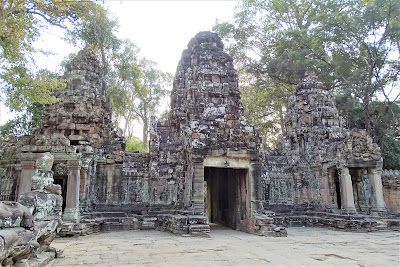31. Preah Khan Temple - Part 1.
This is our
final temple visit. We used only 6 out
of the 7 days we had but we are satisfied with our choice. There is too much so
see on just one trip. And spreading Angkor’s ruins over a few visits was the
best thing to do for us.
is the brother
temple to Ta Prohm. Both palaces, temples were built around the same time.
Preah Khan was built by Jayavarman VII in honor of his father:
Dharaindravarman.
 |
| The Moat (Not Shown) Would be Outside the Boundaries of This Picture. We Entered Through the West Gate But the Main Entrance Is Through the East Gate. |
There is a
reference to a ‘Lake of Blood’ which could mean that the Khmer won a battle
against the Chams (Vietnam, Thailand)
and killed the Chams’ King on the battle field. The Khmer picked this killing
field to erect the temple Preah Khan on it. Good Omens according to the Khmer.
We know a lot about
this temple because steles were found on site and give us considerable amounts
of info:
This temple had
12,500 people living in or very near to it.
18 high priests
were in charge and held daily or weekly rituals.
Over 1000
teachers taught at the Buddhist University then.
615 dancers
were housed and performed for the rituals.
There was a
list of how much gold, silver, how many pearls and how much silk were held for
safekeeping at the temple. It was a very rich place.
The larger area
around this temple held 80,000 ‘common’ folk that supported and supplied this
temple.
Even though
Preah Khan was dedicated to the King’s father and was built to celebrate
Compassion (Bodhisattva) showing the Lord Lokesvara but carved with the face of the King’s father, there were a total
of 430 secondary deities and shrines throughout this city at the time.
 |
| Lion-Headed Figure On Boundary Stone |
The dedication
and grand opening of this temple was in AD 1191.
So it was a
large ‘city’ for its time. It had its own water (baray) reservoir.
The total
temple was built on 56 hectares (<140 acres), surrounded by a wide moat.
The innermost
courtyard is so packed with shrines, stupas, etc. that it is difficult to walk
through. Especially now that ruins are littered about.
We entered
these ruins from the West; Mr. Touch had decorated his tuk-tuk with Frangipani Flowers so Carol felt happy to ride in a flowered transport. She needed this
happiness because it was a very difficult temple to walk through.
 | |
| Most of the Dvarapala (Demons) Holding the Naga's Tail On the Bridge Have Lost Their Heads Very Rough, Uneven Surface |
 |
| Asura (God) On the Other Side of the Bridge Over the Moat |
 |
| Outer-Most Gopura (Gate) |
 |
| View From the Gate - Still a Long Walk to the Temple |
By now you wish
you could find a bench to sit down, but these ruins are merciless.
 |
| Doors |
 |
| Small Shrine |
On the sides of this center walk, once you pass the gallery that surrounds the 2nd courtyard there are multiple shrines, altars, or niches. Some are rubble-filled, some you can access.
 |
| The Sacred Sword Stupa |
We chose to stick with the central walk, leading into the center sanctuary where a stupa marks the spot. This stupa is known as the ‘Sacred Sword’ of the Khmer empire. The lights from holes near the ceiling make this stupa look like a burning candle.








No comments:
Post a Comment